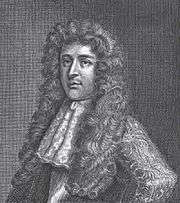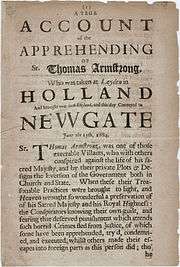Thomas Armstrong (English politician)
Sir Thomas Armstrong (c. 1633 Nijmegen – 20 June 1684 London) was an English army officer and Member of Parliament executed for treason.[1] His father, Colonel Sir Thomas Armstrong (died November 1662) fought in the 30 Years War in the Netherlands, was a royalist soldier during the English Civil War, and was twice imprisoned in the Tower of London by Oliver Cromwell during the Commonwealth.[2]

Life
During the Interregnum Armstrong was a supporter of Charles II, participating in the plot to seize Chester Castle in 1655, and carrying funds from Aubrey de Vere, 20th Earl of Oxford to Charles in exile. He was possibly imprisoned for a year on his return. In 1657, he married Catherine, daughter of James Pollexfen and niece of Edward Hyde, 1st Earl of Clarendon.

Following the Restoration, he received, in February 1661, a commission as captain-lieutenant in the Royal Horse Guards. In August 1675, Armstrong killed the son of one of the queen's ladies-in-waiting at a London theatre. Armstrong was pardoned on the grounds that his opponent had drawn first.[1]
Armstrong served with James Scott, 1st Duke of Monmouth in France from 1672, fighting at the Siege of Maastricht (1673) and alongside the Dutch, in 1678. He was wounded at St Denis. In 1679, he helped suppress the covenanter rising and fought at the battle of Bothwell Bridge, at the same time that the Popish Plot in England was scaring the Anglican establishment.[1]
Monmouth's influence secured him as MP for Stafford in March 1679 to the First Exclusion Parliament.
Death

Following the Rye House Plot, in 1683, he was indicted in the Court of King's Bench for high treason. A wanted man, Armstrong fled to Cleves and then Rotterdam but was captured in Leiden and sentenced to death by Judge George Jeffreys. He was dragged by hurdle to Tower Hill, where he was hanged, drawn and quartered, on 20 June 1684. His head was affixed to Westminster Hall, three of his quarters were displayed in London, and the fourth at Stafford.[1]
References
- Richard L. Greaves, ‘Armstrong, Sir Thomas (bap. 1633, d. 1684)’, Oxford Dictionary of National Biography, Oxford University Press, Sept 2004
- Colonel Sir Thomas Armstrong in thepeerage.com
| Parliament of England | ||
|---|---|---|
| Preceded by William Chetwynd Walter Chetwynd |
Member of Parliament for Stafford 1679–1684 With: Walter Chetwynd 1679 Sir Thomas Wilbraham 1679–1681 Edwin Skrymsher 1681–1684 |
Succeeded by Edwin Skrymsher |